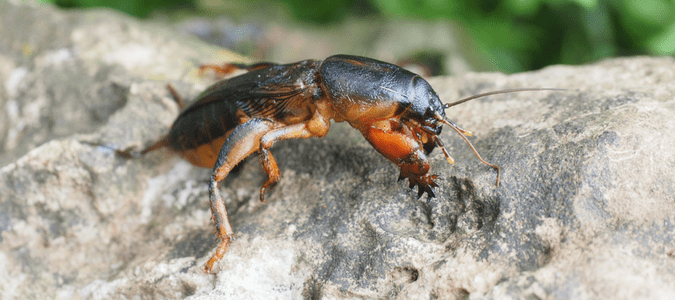
The new furniture is all in place. The moving boxes are (mostly) emptied and put away. Your house is finally coming together. You even made time to plant some flowers in the front and veggies in the back. But one evening you’re sitting out and enjoying the view, and you notice it. Holes and other signs of biting all over your leaves and petals. Upon closer examination, you spot some aphids, so you order some ladybugs to help you deal with the problem. But those two types of bugs are just the tip of the iceberg. Do you know everything you need to know about lawn bugs?
Everything You Need to Know About Lawn Bugs, From A To Z
We have an extensive guide to the many different types of bugs that can infest your yard, what type of damage they can do, signs you might have them and how to prevent or get rid of them.
Ants
Damage Ants Cause
The harm these insects can do to your lawn depends on the type of ant. Large colonies can engage in so much tunneling that it’s bad for the lawn. Fire ant bites really, really hurt. And then, of course, there’s the issue of the ants getting into your home.
Signs You Have Ants
Generally speaking, ants are fairly easy to spot because of the anthills they create. If you see a mound of freshly moved dirt that has an almost sand-like quality, you likely have an anthill.
What to Do if You Have Ants
Whether you are looking to deter or get rid of ants, there are many kinds of herbs and spices that people say are helpful, including cinnamon and cloves. Unfortunately, researchers have discovered that most of these aren’t very effective. Some homeowners pour boiling water into anthills to kill the colony. Truly severe ant problems may require setting out bait or using insecticide.
Billbugs
Damage Billbugs Cause
This is one of many bugs that eat grass roots on this list. Hunting billbugs in the South can cause extensive damage, particularly to Zoysia grass.
Signs You Have Billbugs
The damage hunting billbugs cause is often incorrectly identified as being brought about by disease, drought or even simple dormancy. However, if watering does not help your lawn to recover and if you are able to easily pull up brown grass, billbugs may be the culprit.
What to Do if You Have Billbugs
Regular lawn maintenance helps to control billbugs. Beneficial nematodes can also work. However, the quickest, most effective method is to use broad-spectrum insecticides and to mow your lawn a few days before applying to bring billbugs closer to the surface.
Chinch Bugs
Damage Chinch Bugs Cause
Like many of the other damaging insects on this list, chinch bugs will leave specific areas of your lawn brown and lifeless. How do you know they’re responsible?
Signs You Have Chinch Bugs
Damage from chinch bugs tends to happen in the sunniest areas of your lawn, but there’s an even better way to learn if they’re the reason your grass looks yellow. If you hollow out a coffee can, stick it in the ground and fill it partially with water, any chinch bugs in the area will float to the top.
What to Do if You Have Chinch Bugs
Insecticides work great to control chinch bugs, but if you’re looking for more natural methods, diatomaceous earth has proven to be successful, as has introducing beneficial insects such as lacewings and ladybugs that will feed on the chinch bugs. Regular lawn maintenance also makes it less likely for chinch bugs to gain a foothold in your lawn.
Fleas
Damage Fleas Cause
Though fleas don’t really cause any damage to your lawn, they can hang out there and wait to hop on unsuspecting pets–or people.
Signs You Have Fleas
You’ll have to look for symptoms in the people or animals that were infected, which include scratching, hair loss, scabs, pale gums and tapeworms. You can also dunk your pet in water up to its shoulders. The fleas will rise to the animal’s face, enabling you to better spot them.
What to Do if You Have Fleas
Periodically flood your yard. Simply put, fleas can’t survive this. Other methods include applying insecticides and nematodes to your grass.
Grubs
Damage Grubs Cause
Grubs cause big patches of brown lawn that can easily be pulled up and rolled–almost like a carpet.
Signs You Have Grubs
Warning signs that grubs might be in your yard include brown patches appear in the spring, with dead patches in the late summer and the fall. Your may also notice your lawn feels spongy. Plants and flowers may die suddenly if you have grubs.
What to Do if You Have Grubs
Chemical methods are quite effective in getting rid of grubs, but tend to kill off other insects in addition to grubs, including beneficial insects. Depending on the nature of your problem, you can use curative or preventative chemicals.
If you want to avoid chemicals, you have several options with grubs, including nematodes, milky spore or simply drying them out by not watering your lawn for a few weeks. This should kill them, but could also rob your lawn of the moisture it needs.
Japanese Beetles
Damage Japanese Beetles Cause
Adult Japanese beetles can’t get enough of ornamental plant leaves, so you may expect damage to these garden species.
Signs You Have Japanese Beetles
These insects aren’t particularly shy. Besides noticing ragged, munched up leaves on your plants, you’re also likely to see the beetles themselves walking on the lawn and even laying eggs.
What to Do if You Have Japanese Beetles
Neem oil and insecticides can help manage Japanese beetles, but one of the most effective methods is also one of the most time-consuming and difficult: picking them off of your plants by hand and drowning them in a solution of water and detergent.
Mole Crickets
Damage Mole Crickets Cause
The tunneling of these insects (shown in the photo above) causes the grass to turn brown and die. In addition, these pests eat the grass.
Signs You Have Mole Crickets
Burrows in the yard that are irregularly raised could indicate you have mole crickets. You may also notice dead and dying grass.
What to Do if You Have Mole Crickets
Besides using nematodes, your best way of controlling mole crickets is to use treatments like insecticide baits, granules or sprays.
Red Spider Mites
Damage Red Spider Mites Cause
Southern red spider mites hurt a wide variety of plants, but they are particularly attracted to camellias and azaleas.
Signs You Have Red Spider Mites
Plants that are suffering from a spider mite infestation will show several noticeable signs. First off, they will simply start to look unhealthy. If you look closely, you will see that the undersides of infected plants have what appears to be dust on them. It’s not actually dust; these are spider mites.
What to Do if You Have Red Spider Mites
One of the best ways to get rid of spider mites is to introduce natural predators, such as lacewings, ladybugs, or predatory mites. Insecticidal soaps can also work, but could also kill off helpful bugs or just cause the spider mites to move to a different plant.
Sod Webworms
Damage Sod Webworms Cause
Larval feeding creates small, ragged, irregularly shaped brown spots on your lawn.
Signs You Have Sod Webworms
If you examine the area where you expect sod webworms may be, you might find webbing, silken tubes, and grass that has been chewed off at ground level.
What to Do if You Have Sod Webworms
One of the most important keys in getting rid of sod webworms is knowing their lifecycle, because some things that work well against larva will not work on the adults. For example, Bacillus thuringiensis is particularly effective against the creatures in their early larval stage.
Beyond this, you should use something specifically labeled as effective against this insect and spray in the late afternoon since sod webworms typically don’t come out until night.
Ticks
Damage Ticks Cause
Like fleas, ticks don’t really do much damage to your lawn. But as grass bugs that bite, they can cause you and your pets a whole lot of trouble. Their bites are not only painful, they can transmit serious diseases such as Lyme disease.
Signs You Have Ticks
Unfortunately, the first sign that you have ticks may come after you or a pet is already bitten. Since ticks are one of the few bugs that stay attached after biting, first look for the tick itself. You can also check for a “bullseye” rash where the bite occurred.
What to Do if You Have Ticks
Ticks like wild areas. That means the woods, tall grass and bushy areas. The best way to get rid of ticks and keep them away is to engage in regular lawn maintenance and put up fences so they don’t hitchhike in on animals like deer.
Viburnum Beetle
Damage Virburnum Beetles Cause
As their name implies, viburnum beetles eat viburnum leaves. The damage can be quite extensive, causing these leaves and plants to have a skeletal appearance.
Signs You Have Virburnum Beetles
The most obvious sign is the damage itself, unfortunately. If you notice leaves that are eaten down to the veins, it is quite possible that you have a problem with viburnum beetles.
What to Do if You Have Virburnum Beetles
Quite possibly the most effective way to get rid of viburnum beetles is to find and remove any twigs that have been infested with viburnum beetle eggs. Additional removal methods include introducing predator insects, such as lacewings, lady beetles and spined soldier bug nymphs and using pesticides.
ABC Can Handle Any Lawn Pest
This list is not comprehensive. There are just too many bugs! But it does provide a good overview of some of the most common and dangerous lawn bugs you are likely to encounter. The most tricky part of dealing with pesky lawn bugs isn’t getting rid of them on an individual basis, but coming up with a plan to remove the ones that are causing problems without eliminating helpful bugs or introducing substances that could be harmful to you, your family, or your pets. At ABC Home & Commercial Services, we know how to treat for a particular lawn pest without endangering the other living creatures in your yard.
